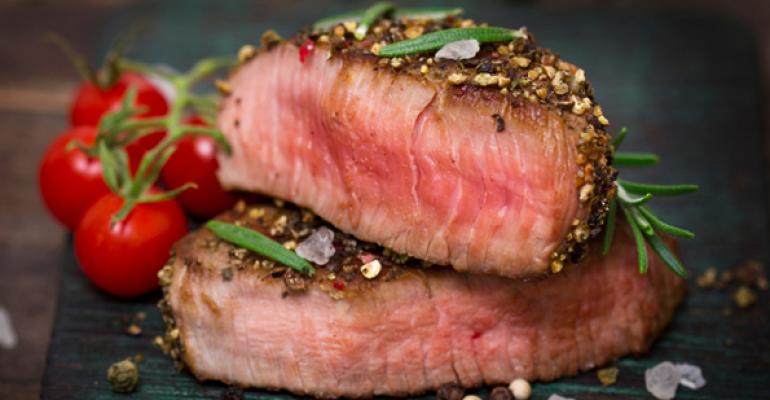With about one million restaurants across the United States, consumers are inundated with options. It doesn’t take more than a new concept or lower prices from the restaurant down the road to lure consumers to the proverbial greener pasture. But it will take more to keep them coming back.
While the foodservice landscape has changed, basic consumer insights still ring true. Consumers will dine where they feel the food is both good and worth it.
And many feel beef is worth it. According to NPD Group data, consumers report high levels of meal satisfaction when they opt for beef dishes while dining out, and even more plan to eat more beef in the future because they just love the taste.
Beef has inherent value to consumers, and operators can rely on their consumers to continue to love beef. But as beef prices have soared, the question remains: Can beef continue to provide value?
Beef’s popularity can work in the operator’s favor if he or she leverages food trends to add value in the consumers’ eye.
Making the most of mainstays
Consumers today — especially Millennials — are deal hunters, and operators should market and menu so consumers can get the most bang for their beef buck. Promotions are one way to draw in consumers — for example, patrons may come for the inexpensive appetizers, but stay for the affordable steak. In addition to well-known promotions, Longhorn Steakhouse also works to mitigate beef costs by pairing smaller portions of beef with other premium proteins. Similarly, Texas Roadhouse pairs steak with their other popular menu items, like pulled pork or ribs, to offer consumers a "Texas Size Combo," for a non-Texas-size price.
Before the industry shifted from a growth to a market-share battle, operators relied on promoting their brand’s iconic items. Now, it is about adding value to those iconic items. If your brand is known for serving burgers, still serve them, but with premium toppings like applewood bacon, or hand-cut French fries. These approaches add value to your brand and product, incentivizing consumers to pay higher prices and allowing you to profit.
Menuing from the middle: Midvalue and middle meats
With the mainstay beef cuts, it can be hard to find the middle ground, jumping from ground beef to the premium steak category. The Ranch Steak was designed to fill in this value gap, and is now one of the fastest growing beef cuts in foodservice today, with volume increasing by 2 million pounds from 2013 to 2014, according to data from Technomic. Hanger Steaks also have seen a lot of success on menus. Mid-value cuts like this present untapped opportunity for operators.
Using midvalue beef as a meal ingredient is a viable option for menuing these cuts. Qdoba does this well by offering steak as a burrito ingredient along with other premium toppings (queso and guacamole) for no additional cost. Similarly, Chicago’s Bar Takito, a new concept, adds value to their affordable beef with a fusion, ethic-inspired twist — like coffee braised beef tacos with a beer tortilla, queso Oaxaca, and pickled squash.
Operators can also flex the versatility of higher-end middle meats (e.g. rib-eye or sirloin) by exploring new ways to cut and menu to add value. Chili’s Grill & Bar offers a six-ounce portioned sirloin on their "lighter choices" menu, while Maggiano’s Little Italy serves peppercorn-crusted Sirloin Cap — both examples of middle meats positioned to work in an operator’s favor while delivering great flavor to the guest.
By experimenting with midvalue cuts and middle meats as a meal ingredient, operators can find the sweet spot of cost-meets-craving.
Fresh from the farm
The industry’s focus on ingredient freshness and transparency will continue to offer new ways for operators to provide value to their beef menu items. Newk’s Eatery provides a close-to-the-source experience by opening its kitchen to patrons. Patrons may watch as their food is prepared, lending a feeling of in-the-moment freshness. More and more consumers are influenced by health awareness, and fresh options appeal to this sense of wellness.
One of the biggest challenges facing the industry is that consumers are now removed from the supply chain; they have no idea where their food comes from — but they want to. This consumer curiosity and investment in food sourcing can be leveraged by operators. I remember when the Angus Association rolled out "100% Certified Angus" beef, and found huge success. Consumers thought that, because it was differentiated from the rest, it was a better quality product. Providing the story behind the beef — where it was raised, who raised it or how — goes a long way in filling in that "farm to table" gap for consumers.
I’m often asked if operators are promoting beef less, and the answer is no — nor should they be. Prices go up and down, but the lure of beef remains. The best operators know how to use that lure in times of low and high prices, as there are many solutions to solve for rising overhead costs, and they all point to creating and highlighting beef value. Beef has profit power — it just needs to be unlocked.

